Apple Tree from seed
Hello knowlegeable people! I have some trees started from my dwarf apple seeds. Folks say you can't do that, they won't be apple trees!!Now!!That whole concept confuses me. What grew from the seed Johnny Appleseed planted? Is this info just because the tree has been polinated from another tree and will have the qualities of both parent trees. Does this mean my dwarf apple tree seeds might produce a full size apple tree or maybe even...crab apples! I hope someone can help fill me in on this information. Thanks!
Your friend in horticulture
Comments (115)
tcamp30144(7B N.ATLANTA)
10 years agolast modified: 9 years agoRelated Professionals
Windham Landscape Architects & Landscape Designers · Foothill Ranch Landscape Architects & Landscape Designers · Sahuarita Landscape Architects & Landscape Designers · Bridgeview Landscape Contractors · Davis Landscape Contractors · East Hanover Landscape Contractors · Forest Hills Landscape Contractors · Hawaii Landscape Contractors · Lebanon Landscape Contractors · North Canton Landscape Contractors · Overland Park Landscape Contractors · Pomona Landscape Contractors · San Antonio Landscape Contractors · San Benito Landscape Contractors · St. Louis Landscape Contractorsnakka
10 years agolast modified: 9 years agohi, I've put some Apple pips out of a Apple put them into a air tight container with damp paper towel inside, they have germinated after 2 months, I've put them into a tray with compost and watered them everyday and I can't believe how quick they have grown after just a couple of weeks I'm chuffed to bits with myself lol. see photo. I was just wondering how often should I water them and what temp I should keep the room at and I cover them at night with a clear plastic bag is this ok to do ? look forward and would appreciate any tips on making them grow bigger and healthier, I would be so sad if they died now. thanx nak
the_Hermit1000
10 years agolast modified: 9 years agoThere seems to be a lot of people wanting to know about growing apples from seeds and a lot of misinformation. I have grown a lot of apples from seeds, so I'll try to explain it here.
The first time I planted apple seeds, they never came up. I did some research and found out that they need a cold and wet period before they will sprout. Those of you who found seeds sprouting inside the apple was because the apple was in cold storage.
I saved the apple seeds I wanted to plant and dried them on a paper towel at room temperature. They will stay viable for several years after drying.
I put the seeds in a moist paper towel and then put them in the refrigerator two or three months before planting time. Put them in a container to keep them from drying out. I like to use a pill bottle set on the end because the seeds usually sprout in the frig and the the roots grow straight down in the pill bottle and are easy to plant. Check the seeds after a couple of months to make sure the roots don't get too long. I'm not sure of the amount of time needed in the cold but plant the seeds after three months rather they have sprouted or not.
Your seedling will not be the same as the apple it came from, although some will be similar.
It takes about 10 years or more for your seedling to bloom and set fruit. Most apple trees need another apple tree for pollination. The more apple trees you have near your seedling the better chance of it being pollinated and producing fruit.
Your apple seedling will grow to be a very large tree. If you want a smaller tree that will set fruit after a few years, buy some dwarf rootstock and graft a cutting from your seedling on it.
If you want to grow your apple tree, or any other fruit tree, in a pot, you need to know that if the roots freeze the tree will die. The roots are not nearly as cold hardy as the top.
Someone was asking if they could take a cutting from an apple tree, put some rooting hormone on it, stick it in the ground and get it to grow. The answer is no.
If you plant a seed from a triploid apple, your seedling will probably be deformed, although a few of them will be healthy. I have a list of triploid apples on my website. http://seedlingapples.wordpress.com
Hermit
sweetpea76
10 years agolast modified: 9 years agoI started about 20 seeds,one lived! so now it is about 3 inches tall and seems healthy. I've got it in my window seal, it hss 12 leafs and more coming..I'm wondering if I should pinch any of the leafs off or just let it go?? I love my little Apple tree:)
sweetpea76
10 years agolast modified: 9 years agoSabar
9 years agolast modified: 9 years agotcamp30144(7B N.ATLANTA)
9 years agolast modified: 9 years agoThank u your tree is nice to mine has grew another 6 inches since pictures
Tracebknibbs
9 years agolast modified: 9 years agoI have read several postings about how to grow from seeds.
Then I read all the complicated postings about grafting and budding. Then I read that you can't grow apples from the seeds you get out of the apples.
Well my reply to that is, THAT IS THE STUPIDEST THING I HAVE EVER HEARD.
People, where do you thing the original apple trees came from, SEEDS. there was no grafting and budding back then it wasn't even never heard of.
But because of all the grafting they have been doing we won't know what the original apples (doesn't matter what kind) will taste and look like if you don't grow them from their own seeds. I can't grow them where I live now, which is Saskatchewan, Canada. But next year I am moving to Vancouver Island Canada which has a 8-9 for a growing area. I am going to start them this winter, hopefully they will grow for me, and I will be planting a Mac Apple tree in my new garden. Have a great night, remember gardeners
Spring is just around the corner.
Thanks for readingtheforgottenone1013 (SE MI zone 5b/6a)
9 years agolast modified: 9 years agoGrafting has been around for a long, long time. Yes, the original tree of a certain apple variety was most likely started from seed (or it could have been a sport branch) but they have been perpetuated via grafting.
Nobody has said you can't grow an apple tree from seed. What was said is that you won't know what kind of fruit a seed will eventually produce. The fruit might be vastly inferior to the apple it came from, it could be similar, or it could be different but excellent. It's impossible to know.
Rodney
hamboner
9 years agolast modified: 9 years agoNickajack apples come true to seed or very close to it. One of only a handful to do so. A Cherokee apple. Trees still sold by southern nurseries Big Horse Farm, Urban Homestead.
John D Zn6a PIT Pa
6 years agolast modified: 6 years agoIt's my opinion that if you control what the parents are you can get usable apple trees from seed.
http://scholarworks.umass.edu/cgi/viewcontent.cgi?article=1894&context=dissertations_1a study from 1896- 1916 they crossed a variety of apples the results are there for you to read. Looking this over I see that at least half the seeds produced apples. They were large, retained color, taste, texture, and they reproduced in about the same time as it would take a grafted seedling. Some in 3 years, the largest number produced at 5 years. Some took 10 years as the horror story goes.
It's my opinion that if you use two apples to pollinate a blossom from the chosen apple variety you'll get the same apple. Take Rome Beauty or Jonathan. They do not need another variety to pollinate. I'm afraid that the Jonathan has to much work done on it so use Rome. If you hand pollinate as this T Budding video from Penn State shows.
I think you'll get a lot of good Rome trees for the future.
Some of the horror stories are I think where a crab apple was one of the pollinators. I have a crab apple story from SW Pennsylvania. I owned 40 acres that had grown in. There were a lot of crab apples, some places so thick that I couldn't get my shoulders thru them. There were thousands of them. But there were only 3 that produced apples. The deer ate them. When there was 6 inches of snow, I'd seen them pawing, looking for rollers. Only when they found a roller did they stick their noses into the snow. A surveyor told me they'd all disappear, which they did. I helped them along by cutting down the 3 what I called master crabs.
I also think if you had an orchard of Rome apples and you cut out any flowering crabs and also could keep out any other apple trees you'd get a lot of Rome apples by planting the seeds from your apples.
John D Zn6a PIT Pa
6 years agolast modified: 6 years agoT budding could be another option.
https://www.youtube.com/watch?v=LTqG8-OhElY&feature=youtu.be
Another thing to think about. When a sucker grows from the roots of the rootstock , instead of trimming it and discarding what if you graft a bud from another tree to it. Either root the rootstock and then graft, or graft to it and let it grow where it is. I think you'd probably have to pay a royalty to the rights owner of the rootstock and maybe for the bud source. But it lets you experiment on a onesy basis.
jolj
6 years agoBy PAUL WHEATON
There is this story going around that if you try and grow apples from seed, then there is only a 1 in 20,000 chance that you’ll have an edible apple. That’s a pretty daunting statistic. No wonder more people aren’t starting trees from seed.
But what if that wasn’t exactly the case?
That myth is founded in a spec of truth. Actually, there is a 1 in 20,000 chance that you’ll grow an apple that can out-compete MacIntosh or Golden Delicious in the open marketplace. That is a 0.005% chance it will be the next amazing supermarket industry apple.
Growing an apple tree from seed won’t be true to parent. And that is ok. The odds of growing a really good apple is not 1 in 20,000. In fact, it is actually about 20%. There is also a 20% chance that the apple will be a ‘spitter’. A nasty, mealy crab sort of an apple. The remaining 60% will produce apples that are ok. Good for one thing. They may be good for juice, or good for apple sauce. They may be good winter keepers. Or just an average edible apple. Heck — they could even be good pie-baking apples.
Photo by Dave Miller
Now that’s a game-changer. 80% of seeds planted will turn into a few excellent apples and lots of ok apples. And not just apples. These figures are the same for most fruit trees. But what if you plant a seed and an apple tree pops up and you don’t like it? What if it is the ‘spitter’ variety? The kind of apple that as soon as you chomp into it you spit it right back out? No problem. Cut it down and add it to the hugelkultur pile. Seeds are so crazy cheap and easy to come by…there’s plenty more where that came from.
A single apple can have between 5 – 12 seeds. Boy — if we really did an apple a day to keep the doctor away that’s 1825 – 4380 seeds in one year.
Another way to integrate the less than awesome tasting apples is to leave them for the wildlife, pigs, chickens, and cattle. They make a great animal feed especially for paddock shift systems in the winter. They will enjoy them even if we don’t.
Growing an apple tree from seed, as opposed to transplanting, allows the tree to have a taproot. There is a lot of value for a tree to have a taproot. The taproot is the main nutrient conduit. It penetrates deep into the soil giving the tree more access to minerals. The taproot allows the tree to be more drought tolerant because the tree can harvest water from varied depths. And it anchors the plant. Creating an overall healthier, stronger tree that can withstand severe weather conditions. Have you ever seen trees that have been blown over in a storm? Ever notice in those pictures how only a cluster of surface roots are visible, but not the taproot?
Trees without a taproot have all of their roots close to the surface where they are competing with grasses for nutrients.
Besides all of these benefits, planting a tree from seed is only about 1000 times easier than fooling with something in a pot. And don’t get me started with all that grafting nonsense (otherwise known as bloodying your thumb).
Take the next 10 seeds from the best tasting apple and let’s experience apple trees the way Mother Nature intended. Odds are 8 of those 10 are going to be pretty damn good.
****************
Paul Wheaton is is the tyrannical ruler of two on-line communities. One is about permaculture and one is about software engineering. There is even one for Missoula. Paul has written several permaculture articles starting with one on lawn care that he presented at the MUD Project 17 years ago, including articles on raising chickens, cast iron and diatomaceous earth. Paul also regularly uploads permaculture videos and permaculture podcasts. In his spare time, Paul has plans for world domination from his hollowed out volcano in the Missoula area, with good submarine access.
See all of Paul’s contributions to Make it Missoula here.
This entry was posted on Friday, May 9th, 2014 at 10:01 am
Category Archive: All Featured, All Food & Drink, Going Green, Green Living, Paul Wheaton, Sustainable Living
Tags: Missoula, Montana, PAUL WHEATONhttp://www.makeitmissoula.com/2014/05/apple-trees-from-seed/
emerogork
6 years agoApparently, Johnny Appleseed was only concerned in producing AppleJack. Drinking alcoholic beverages back then was preferred because clean water was not all that available as it is today. The quality of the apple was not all that important.
John D Zn6a PIT Pa
6 years agolast modified: 6 years agoI wrote my comment, two days ago to support those who'd like to grow an apple from seed. To give some argument to the horror stories you hear about growing seeds. It's my opinion that if you grow a seed from a hybrid apple you bought in a store then the horror stories may have some substance, even if overblown. But if you think about your project before you eat the apple you get the seed from you can improve your chances tremendously.
I looked in the Stark catalog as my source of which apple will self pollinate. They listed two which I mentioned. I'm sure there are more. You also need to look at your apple source. My apple was Rome Beauty, one of the two. If you find an orchard that specializes in that apple you'll vastly improve your chances of success. If an orchard only grows Rome apples then the bees will only graze Romes for pollen. Well mostly!! Rome apples are grown in central Ohio and eastern Indiana. They grow some here at my local orchard, but they also grow a variety. Perhaps your local source comes from Ohio/Indiana.
I don't have any experience doing this, I just thought a little and did some research. I do have 40 years experience growing heirloom tomatoes from seed so I'm not afraid of growing something from seed.
Look over the study I posted to a couple days ago, I think you'll be encouraged.
John D Zn6a PIT Pa
6 years agolast modified: 6 years agoI found a study from Ohio Agricultural Experiment Station in the 1930's which studied Apple Self Fertilization on several apple varieties at:
https://naldc.nal.usda.gov/download/IND43968367/PDF
The study shows that some apples will self fertilize and some produce zero results. In the summation it says "On the basis of comparison with open-pollinated limbs, the degree of self-fruitfulness approximated 25 to 50 percent of a full crop. These varieties ( Rome Beauty and Gallia Beauty) can be termed *'partially self-compatible.^" I looked up the Gallia Beauty and it exists out there but it's not popular enough to make the spell checker here.
I came to the conclusion that with some varieties of apples no matter how much pollen a bee hauls in the pollen just can't fertilize the blossom. Picture a bee on an apple tree in blossom. I'd think that he spends a good bit of time on that tree and while he might fly down and pick up some clover or dandelion pollen he's going to be loaded with pollen from that apple tree. But it just won't pollinate itself. I also came to the conclusion that an orchardist WILL have a pollinator tree even with Rome or Jonathan apples. So while some apples may have seed that reproduce a Rome or Jonathan it's going to be a gamble.
I do think that if you make a pie with Rome's in it ( which is one of my preferences) and plant a seed from 5 different Rome apples and let them winter over that you may get something. It you increase the number of hills ( and pies ) you'll increase your odds, of getting a Rome. Hopefully you'll get at least one Rome. I'd just cut out the ones that don't give me what I want.
I'd like to experiment with this on my own, but I'm too old and I don't have a Rome or a Jonathan apple tree My Brother In Law has a Jonathan. I'll have to talk to him.
jolj
6 years agoAll fruit trees/plants do better when you have 2 or more planted in a row or circle.
The bees will cross pollinate, even if they are self pollinator plant, there for more than one plant will get you more fruit per plant. Self pollinate just means you can get some fruit with one plant.
emerogork
6 years agoI have been sporting a 10 year battle with two plum trees that never produced. It took five of those years to convince the nursery that they were not common pollenizers. Then they realized the mistake, I was given a dwarf St Rosa plum being a self pollenizer. (Pollinator?)
That first year, I had hundreds of plums on one old and the new trees. I removed the lone that flowered out of sync with the others. Then I learned about plum curculio insect and black rot.
However, for the next few years the two yielded fewer and fewer plums.
Something affected the new dwarf and it died a slow death. In the final year, the other tree produced ONE plum. That was when I said that I have "A-Plum" tree.
All three three have been removed.....
John D Zn6a PIT Pa
6 years agoI'm taking self pollinate to mean that I'll get an occasional seed that will produce the same plant as the parent. I'm fairly confident that it'll work on a Rome. I'm unsure about Jonathan cause when I look in a seedling catalog there seems to be lot of "Improved" Jonathans; so I'm not sure what I'd get. In the study I linked to a couple posts ago he seems to suggest that Romes will do that. He was only interested in studying the amount of crop you could expect. He didn't carry the study as far as I'd like to see.
I'd be interested in seeing what percentage of true to parent seeds you'd get by pollinating by hand and then covering the branch with a cheese cloth to further isolate the parentage.
jolj
6 years agoNot to be confused with self-compatibility in plants, the ability to form seed using self pollen
One type of automatic self-pollination occurs in the orchid Ophrys apifera. One of the two pollinia bends itself towards the stigma.
Self-pollination is when pollen from the same plant arrives at the stigma of a flower (in flowering plants) or at the ovule (in Gymnosperms). There are two types of self-pollination: In autogamy, pollen is transferred to the stigma of the same flower. In geitonogamy, pollen is transferred from the anther of one flower to the stigma of another flower on the same flowering plant, or from microsporangium to ovule within a single (monoecious) Gymnosperm. Some plants have mechanisms that ensure autogamy, such as flowers that do not open (cleistogamy), or stamens that move to come into contact with the stigma. The term selfing that is often used as a synonym, is not limited to self-pollination, but also applies to other types of self fertilization.
John D Zn6a PIT Pa
6 years agoOn page 12 of the Stark Bros catalog of 2017 for Red Rome Beauty it says "Self-Pollinating". I think that's what I mean. Whether I do the pollinating or a bee does the job is of little difference to me. Except that if I open a ballooned blossom and get the job done and then cover the branch with cheese cloth I'd be a little more certain of the fact that the seeds produced were of RomeXRome parentage. As has been done for at least 100 years according to the learned studies posted above.
As I understand what Stark Bros means by the Self Pollinating is the tree is capable of being pollinated by pollen from the same variety of apple tree, I don't really know if the tree will pollinate from pollen from the exact same tree. But that's worth exploring in a future 10 year study. I think what's more important to me is if I can produce an apple tree true to its parent tree from seed which is what this thread is about.CPTK
6 years agolast modified: 6 years agoIt's a pretty fun idea to grow a seed from an apple you ate, but ultimately the only practical use would be as a pollinator. Even that use is dubious because you can just grow two different varieties so they pollinate each other. An otherwise useless pollinator is unnecessary in most cases.
The plant that comes from the seed will be useless as a stand alone tree because apple doesn't grow true to form from seed. It will also be useless as a rootstock because it hasn't been selected for any trait that is beneficial as a root stock.
However, that guy that already has a 21 year old useless tree might as well order some scion of a tasty apple variety and graft it onto his tree. If he only has the one tree, he can even leave half the tree as is so it pollinates the variety he grafts on.
mccommas
6 years agolast modified: 6 years agoHey CPTK, you are a jerk! With apples being as cheap as they are, its hardly because we are all starving and need apples to live and can use the only the most perfect named apple varieties. No, we are growing the trees for fun and the sake of the trees themselves. --At least I am. We all grow lots of other trees that provide no nutritional value don't we, like dogwood? I like the idea of planting a tree that will long outlive me even though Apple Trees relative to other trees are comparatively short-lived. Apple blossoms are gorgeous in the spring and I for one appreciate any tree for its beauty. As for the updates, I got lots of them growing on my property and I have transplanted four bigger ones to public areas through my town's Garden Club. I found out that the Apple Trees really don't like being transplanted once they get to be four foot tall or larger so plant them when they are small in the place you want them to mature whenever possible. The largest transplanted apple just barely survived the hot summer and required me to haul water over there for weeks and still might not make it to Spring. My favorite tree (from a Pink Lady) is about 8 feet tall now and it had a small sprig of blossoms this past spring. I couldn't believe it! Its only about five years old! Disappointingly the blossoms did not produce anything. We have lots of flowering crab apple trees on the property but the problem may have been a lack of bees in New England that time of year. I have noticed some of the trees mature to be rather lanky ( ungracefully thin and tall) rather than full. I have tried trimming the longest branches to encourage the rest of it to fill in.
CPTK
6 years agolast modified: 6 years agoI grow things for the sake of it all the time. I just enjoy gardening and plant propagation. I agree with everything you said about growing things for the joy of doing so. Was it the word "useless" that upset you? I meant useless only from the standpoint of producing edible apples.
jolj
6 years agoMost gardener & orchard manager fill the same about growing CPTK.
Apple seeds will not bare fruit for 10 years.
John D Zn6a PIT Pa
6 years agoFrom my post of 10/15/17:
"....they reproduced in about the same time as it would take a grafted
seedling. Some in 3 years, the largest number produced at 5 years. Some
took 10 years as the horror story goes."That came from a 10 year long study over a hundred years ago. The link is in that post.
I once planted a grafted dwarf apple seedling. Twenty years later it produced ONE blossom. I had sold the land. The year of the blossom they excavated 19 feet deep to put in the road, and dug out that apple tree. But I would never make the statement that "from a grafted seedling you'd be lucky to get one blossom in twenty years."
There are people out there that make statements to encourage you to buy their products. It wouldn't be good for the industry if folks figure out how to get good apples by planting seeds. If you think about it; many of the apple varieties out there came about from those who planted seeds.
I think it's important to realize the difficulty of what one wants to do and do some thinking on how best to accomplish the goal. With the internet we have in our homes the ability to review decades and centuries of studies. To look at years of work and realize the benefits of those who had the same inspirations that we now have.
CPTK
6 years agoYeah, you could definitely discover a new fantastic variety by growing seeds. But the probabilities are daunting. You would need a much more efficient operation than the average person can muster to go through the sheer number of iterations necessary to discover something great.
jolj
6 years agoMost of my store bought fruit trees grow for 5 year then put on fruit, I grow standard
trees. My MoonGlo pear did not fruit for 5.5 years, from seeds add 3-5 years.
But that is my orchard, do not know about ALL trees, berry bushes produce first or 2nd year.
emerogork
6 years ago" grow things for the sake of it all the time."
I did not realize how wide spread this is. Every year, I grow 3 - 4 types of tomatoes, corn, peas, carrots, cucumbers and the like yet I really don't like these fruits and vegetables. I usually just give them all away but I do like growing them....
John D Zn6a PIT Pa
6 years agoCPTK
I'm not thinking of growing a new variety of apple. I'm 73, I'm looking for something quicker. Just as a hobby.I think I could grow a Rome Beauty, or possibly a Jonathan. If they self pollinate then they'd produce viable seeds that grow another tree of the same variety. I think.
They'd be a full size tree, with a tap root. A good source of scions. A good source of apples. A good source pf apple pie.
Or so it seems to me. I think if you look for reasons that a project won't work, you'll never finish the project. If, instead, you look for a way out of the road blocks you've got half a chance.
If I believed the stories about taking 10 years to produce an apple then I don't have the time. But if I believe the guy who did the study 100+ years ago; then I believe that I can get lots of apples at 3 years, many more by 5 years. I can pursue this.And I would rather pursue apple varieties that have half a chance of working; than to pursue the latest fad apple.
gardengal48 (PNW Z8/9)
6 years agolast modified: 6 years ago"I think I could grow a Rome Beauty, or possibly a Jonathan. If they self pollinate then they'd produce viable seeds that grow another tree of the same variety."
Unfortunately, this is a bit of an over-simplification :-) The reason most apples are produced from grafted trees is that apples don't breed true.
In a large number of crops, you have "lines" of crops. Basically, if you breed two plants of the same cultivar together, their offspring are similar enough to both parents that it performs like the parents. The reason for this is that these crop lines have been interbreed with each other for long enough that the population is self consistent, and the important alleles are present in frequencies that mean all progeny are likely to inherit them.
However, the types of apples which are sold commercially are not from these sorts of cultivar lines. Instead, they've been obtained from "sports". That is, the chance production of either a particular hybrid gene set, or sometimes from random mutations that happened on an adult tree of another apple variety. For example, the Granny Smith occurred from a chance seedling which was discovered by Maria Ann Smith.
These apples don't necessarily have "consistent" alleles. For example, it may be heterozygous for certain genes. If you have Aa alleles at one gene, if you self-pollinate the plant, you're going to get a mix of AA, Aa and aa genes in the offspring, the last of these isn't going to be the same phenotype as the parent. Now recognize that this is happening at multiple genes across the entire genome, so there are many chances to get non-parent-like allele combinations. Add to this the issue of co-dominance, where the heterozygote has a different phenotype than either homozygote (that is, BB isn't like Bb), and the chances that an offspring has a gene with a non-parent like allele combination is pretty high.
Now you can certainly grow apple trees from seed. The planted seed will grow up into an apple tree, but the chances are that the combination of alleles it received by random chance from its parents will not result in an genotype that produces any commercial apple phenotype. Instead, you're likely to get regression to the mean, meaning the apple tree will be like the ancestor of apples - a crab apple, or at least crab apple-like. But there's a small chance that it will have commercial apple-like properties, which may or may not be like the parent. This is how new apple varieties are formed, after all.
The only way to guarantee that the genotype of an apple tree is close to the parent plant is to propagate it by cloning, and the easiest and cheapest way to clone trees (at least apple trees) is by grafting.
And even so-called self fertile apples are at best only partially self fertile. Fruit production on these is usually very scant compared to trees that are offered cross pollination.
John D Zn6a PIT Pa
6 years agoYou seem to know what you're talking about.
It bothers me that in the studies I looked at; there were a few cases where they had a, for instance, RomexRome but they weren't pursued. They just seemed to disappear. Like, maybe they were a mistake. Like something they were afraid to pursue. Or maybe they knew what they'd get. Something the users of the study didn't want to know about. I don't know how they'd be so sure of what they'd get since what they were looking for was the unexpected.
Why would the unexpected result of a RomexRome cross be undesirable. I think it needs pursued. I can't do a major study, but I can do a few, 20 or 30. I don't have a source of Rome study material, which I think might be the best choice, but I have a source for the Jonathan.
I'm not blindly going into this ignoring the obvious. I grew a peach tree from a stone. It never bloomed, right near the grafted dwarf apple that didn't bloom for 19 years. I'd have cut down the peach but the dog liked the shade, so I used it for a shade tree.
John D Zn6a PIT Pa
6 years agoI went back to the study from 1896-1916:
http://scholarworks.umass.edu/cgi/viewcontent.cgi?article=1894&context=dissertations_1
on page 130 of the pdf file (The typed page numbers don't match) discussing the cross of Wagener and Rome the study points out that 70% of the apples from the crossed seed were of medium to large in size.
So there goes that horror story about getting crab apples.
On page 35 (pdf) we see a graph showing the age of first fruit. The greatest preponderance of the three crosses bore fruit at age 4-6 years of age. The largest number is at 5 years.
As far as what the results might look like there are 3 results of the offspring page 24 (pdf)1. Like the Female
2 Like the Male
3 A blend of the twoIt says: Occasionally a cross may result in an F1 generation totally unlike either parent in the character under consideration.
Note: it said occasionally. But that's with two different parent varieties of apples.
So what should I think will happen with both parents of the same variety?John D Zn6a PIT Pa
6 years agolast modified: 6 years agoRemember the horror story that what you'll get if you plant an apple seed may be a crab apple. Looking thru the sturdy linked to above he mentions getting 4 crab like plants out of 321 seedlings crossed with Ben DavisXJonathan parents. That's just above 1%. But if we look thru the entire discussion about tree shapes where he mentions the crab apple on page26 (pdf) he discusses 980 seedlings of mixed parents and those 4 are the only crab apples he mentions. That comes out to be just under 4/10 of one percent could be crab apples. Oh dear what a problem.
What I would do is take my shears, my hand saw or chain saw and cut that crab apple down as soon as I saw the thorns. I hate the thorns, remember I'm the guy with the property that had thousands of crab apples. I picked my waterproof boots by using the criteria that crab apple thorns didn't go through the soles/heels.
So who's the guy spreading the myth about getting crab apples by planting an apple seed and what's his agenda.
To be honest these seedlings were controlled pollination, Out in the wild you'd get some crosses where the bee found a crab apple tree yesterday or was it Monday. Seriously if I were to try my RomexRome or JonathanxJonathan I'd also control the pollination.
John D Zn6a PIT Pa
6 years agoI came to a realization today concerning the discussion of waiting 10 years for apples grown from seed. Some people are looking at the first apple produced by the tree. Commercial growers are concerned about when they fill their bushels. I'm not sure what a homeowner would consider as a gauge. 10 apples, enough for a pie and a few to eat. Don't know. But I think the study I've linked to is talking about the first fruit. Let me try to put up the graph from the UMass study, on page 35 in the pdf file.
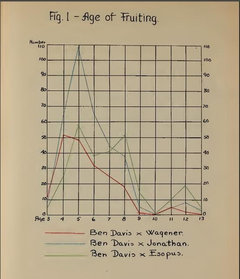
You can see how much fruiting occurs at years 4,5,and 6. At 10 years, the horror story age, it's almost zero. But that's first fruiting, I think.
So while an orchard might be concerned about mow many bushels at a certain age. When we discuss what we might get from our experiment we should be happy to get a single ripe apple from any tree we've grown from seed. If it's a crab, or a spitter we can make it into a tomato stake.John D Zn6a PIT Pa
6 years agoIt it's a crab I could graft a scion from one of my good trees. That way I'd get a smaller tree that dies in twenty years like the thousands of crab apples did on the property I used to own.
On a different subject. We made an apple pie yesterday for today's Thanksgiving dinner. We used all Golden Delicious. My wife's favorite apple variety. Threw the cores in a fence row and the peelings in the grass outside the kitchen window. Within 10 minutes a doe showed up, ate the whole pile. Probably a chipmunk found the seeds in the cores. If not some new variety of apples in about 4, or 5 years.John D Zn6a PIT Pa
6 years agoI found this list at:
http://www.homeorchardsociety.org/growfruit/apples/self-fertile-apples/
Notable apples that will self pollinate, just some from that list:
Braeburn
Earligold
Golden Delicious
Granny Smith
Granny Smith, Greenspur
Grimes Golden, possibly same apple as Golden Delicious
Jonared
Jonathan only partially self fertile on this list
Red McIntosh
Red Rome
Snow Fameuse
Wolf River
There are 125 Apple Varieties on the list, there are also a lot of commonly available apples on the list that they list as partially self fertile.
I'm posting this here as I feel it improves your chances of producing an apple tree they'd you'll be happy with if the apple seed you planted is on the list.
But if you control the fertilization I think you'll get a high degree of success.ubro
6 years agoyou seem to be on a good quest johnfdua have fun with your seedlings. I am dabbling in growing a few seedlings each year, some I cross, some I just seed from apples I grow. I ran across a study from the University of Sask fruit program, they said that to speed up the juvenility phase of an apple seedling you cut and graft it to a larger existing tree. The time till first fruit should be significantly shorter. I can't find the paper anymore but I do believe the timing for this is around the second or third year of the seedlings life.
My aim is to get a good eating apple that survives our cold zones, I am not interested in necessarily a commercial one, just a tasty one.
John D Zn6a PIT Pa
6 years agoI am going to trust the learned study above, the one that shows the graph of how long it took to first fruiting. It's my opinion that it may take less time to produce an apple from trees grown from seed than by going through all that hoopla.
The reason for grafting is to produce a guaranteed tree that will produce an exact replica of the original tree, or to change the size of the entire tree. I'm more interested in knowing whether I can grow an apple tree that will give me a somewhat similar apple. I'd also like to know what are really lies about what will happen if you think out a way to grow what you want with seeds.
If I can grow 10 trees from seed and that method will work then I'll get some good trees out of those ten test seedlings. I don't need a test of hundreds or thousands. If the idea works then it will work with a test of the ten seedlings. I think.....hope.John D Zn6a PIT Pa
5 years agolast modified: 5 years agoList of precocious apples, those that produce fruit at an early age.
Ben Davis
Braeburn
Brownlees Russet
Calville Blanc d'Hiver
Cortland
Cox's Orange Pippin
Duchess of Oldenburg
Empire
Esopus
Freedom
Ginger Gold
Grimes Golden, same apple as Golden Delicious?? Orange Pippin.com says it's precocious
Jonathan
Redfield
Wagener
Wickson
Yellow Delicious (Everfresh)
Yellow Transparent AKA Glass Apple
Zestar
Not So Common apples:
Akane (op.com)
Alexander (op.com)
Anna (op.com)
Apricot apple named for its taste (op.com)
Arlet
Bardsey
Bedan
Benoni
Boiken
Charden
Cheerfull Gold™
Chenango Strawberry
Chisel Jersey
Cosmic Crisp™
Dorsett Golden
Early Blaze
Emneth Early AKA Early Victoria
Falstaff popular UK apple
Florina
Gladstone AKA Jackson's Seedling
Mann
Mairac® Swiss apple AKA Flamboyante
Smokehouse Stark Bros: "Years to Bear 2 - 5"
Needs Verification:
Golden Delicious Needs verification Not specified by OrangePippin, Stark, and USDA ARS (Smoothee, Razor, Badami, Starkspur, Doud, Empress Spur, SE-69) My semi-dwarf produced 4 apples in the third year.This is a partial list, I'll add to it as I find more. I'm thinking that if one of the parents is precocious the offspring will more likely be precocious. So if you add a tree to your orchard, you might consider the list if you want to grow apples from seed in the future. If your buying apples at the store I will guarantee that the mother of that apple is the type of apple you bought.
Another thought is that if you plant an apple you like eating you'll improve your odds of getting good apples from seed. The Cox's Orange Pippin is widely considered to be one of the best dessert apples. It's also on the list above. So by planting seed from that one apple you're getting a shot at two very important trait
To be truthful, if you want to carry the precocious, or any other trait thru seeds that you plant it'd be helpful if both parents carried the same trait.
authereray
5 years agoPersonaly I wouldn't mind having a Crab apple cross as they would make good cooking apples and make wonderful jelly. If my seedling apple tree ever makes apples I don't realy care just so it makes apples. Other people may have different reasons for wanting a particular kind.
ubro
5 years agoI agree authereray, for me the excitement is in the unkown. Hey, time passes quickly and these seedlings don't take much care once they establish.
authereray
5 years agoubro, I found my apple seedling growing in my garden and let it grow where it was the first year then moved it to it's permanent spot where it is over 10 ft. tall now and I can't remember how old it is. I'm hoping for apples and if they are sour crabs I will be happy.
ubro
5 years agoI crossed a Trailman with a Peasgood Nonsuch. My sister sent me the flowers from Peasgood so I could get some pollen. The seedlings, and there are 3 of them, are in their 3rd winter.

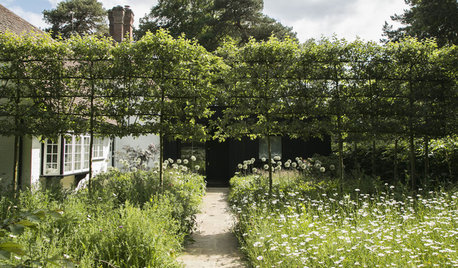


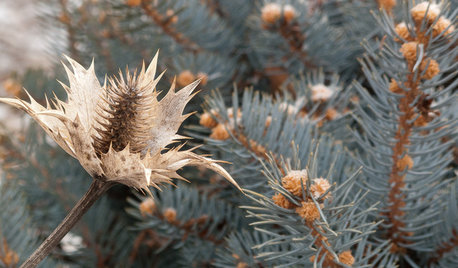

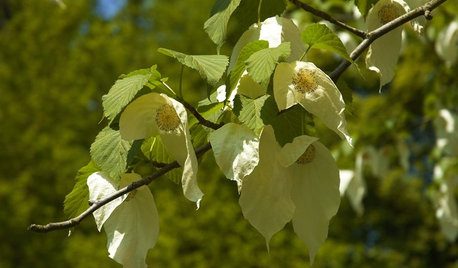









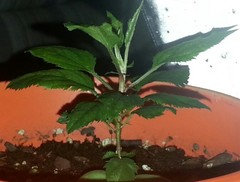

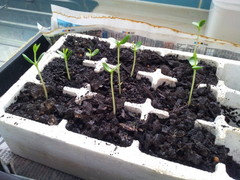
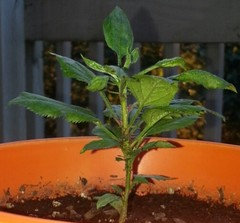
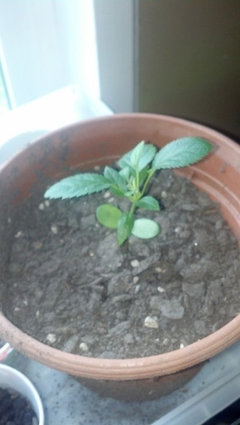


vegangirl